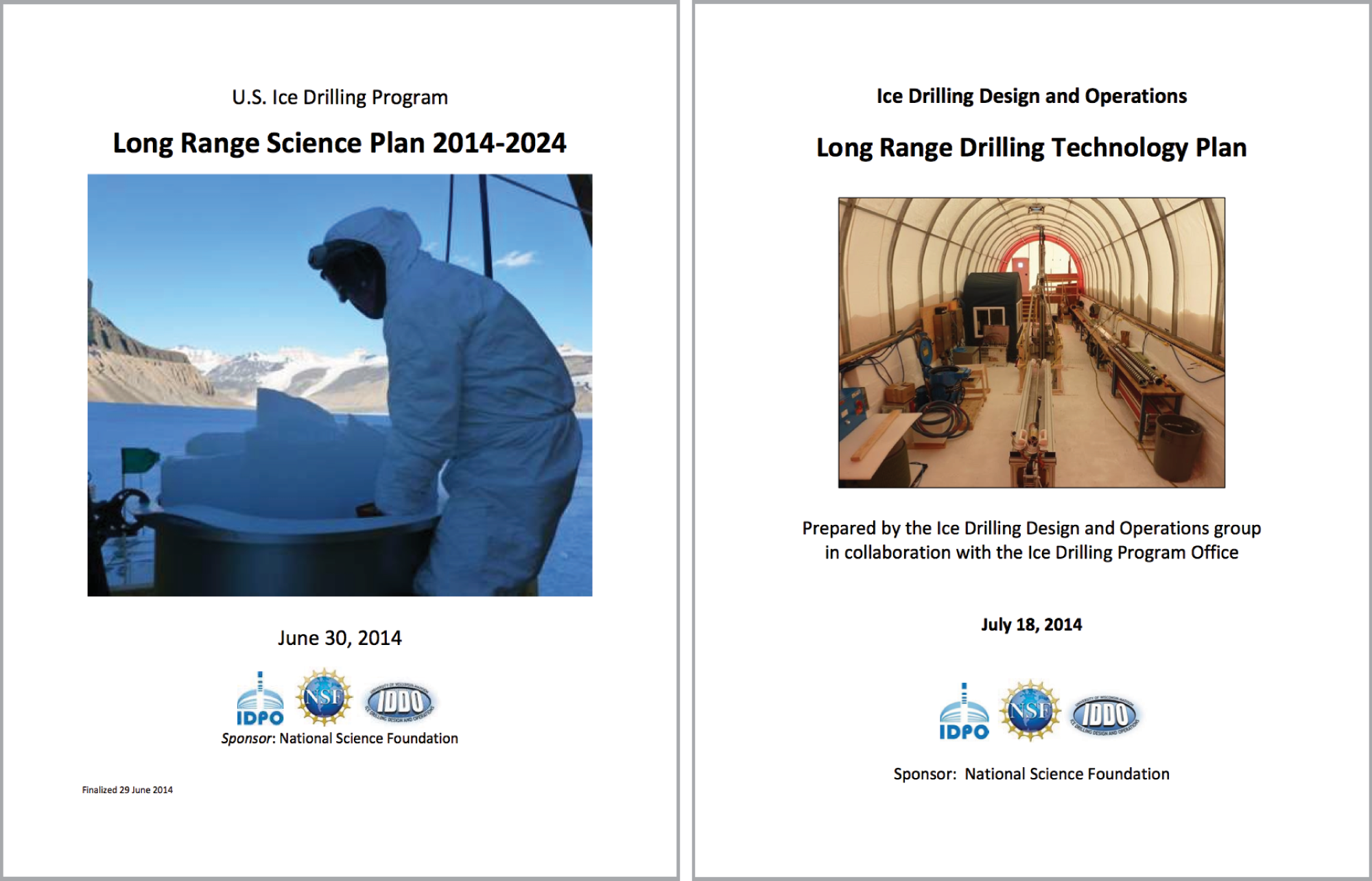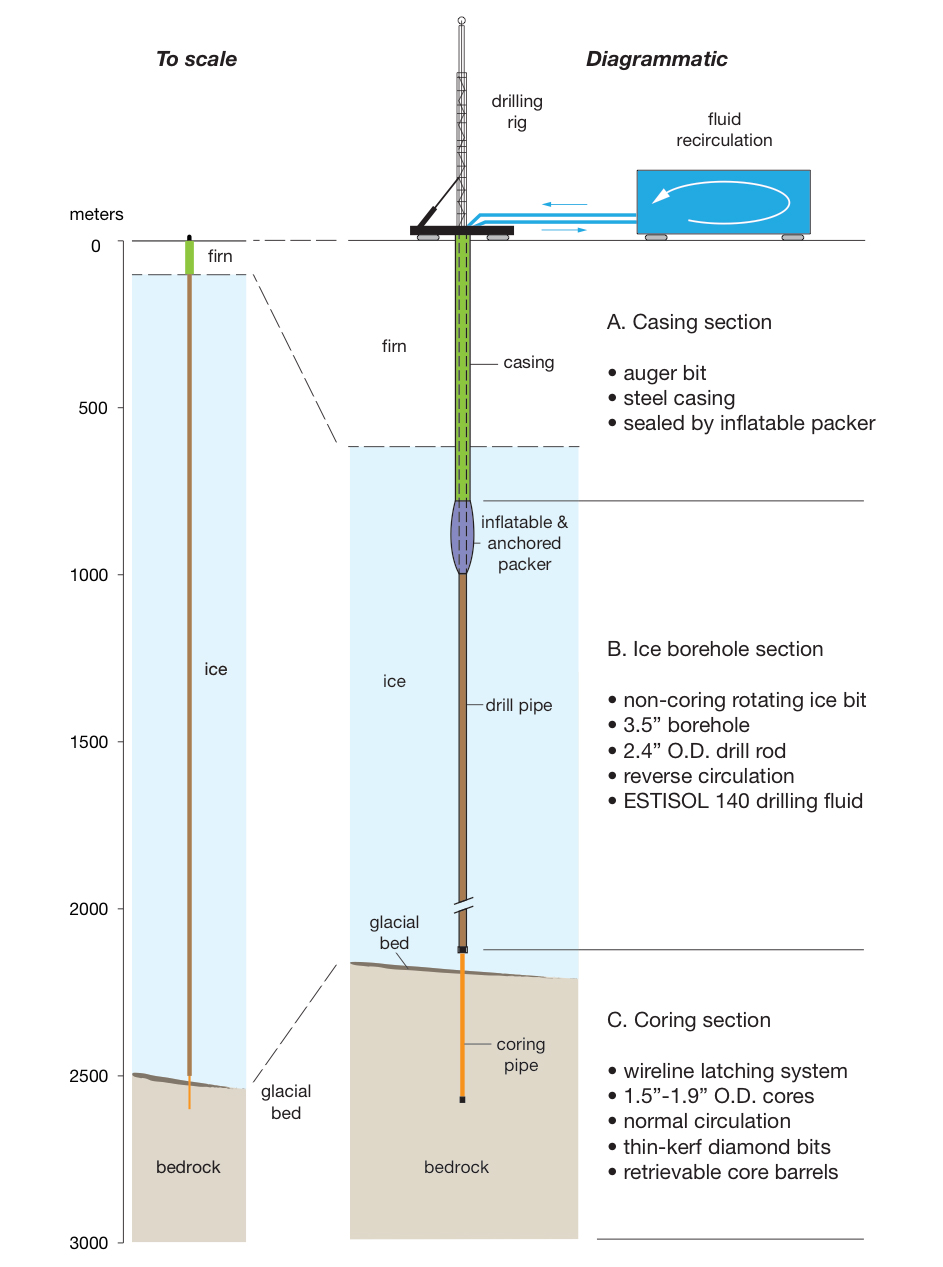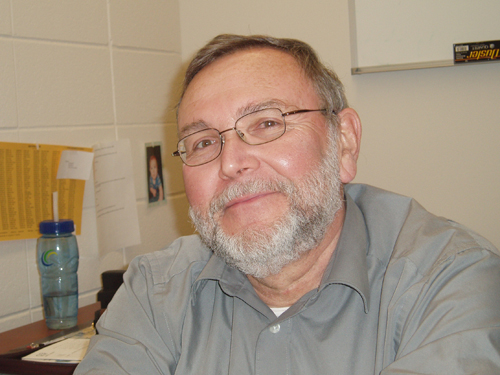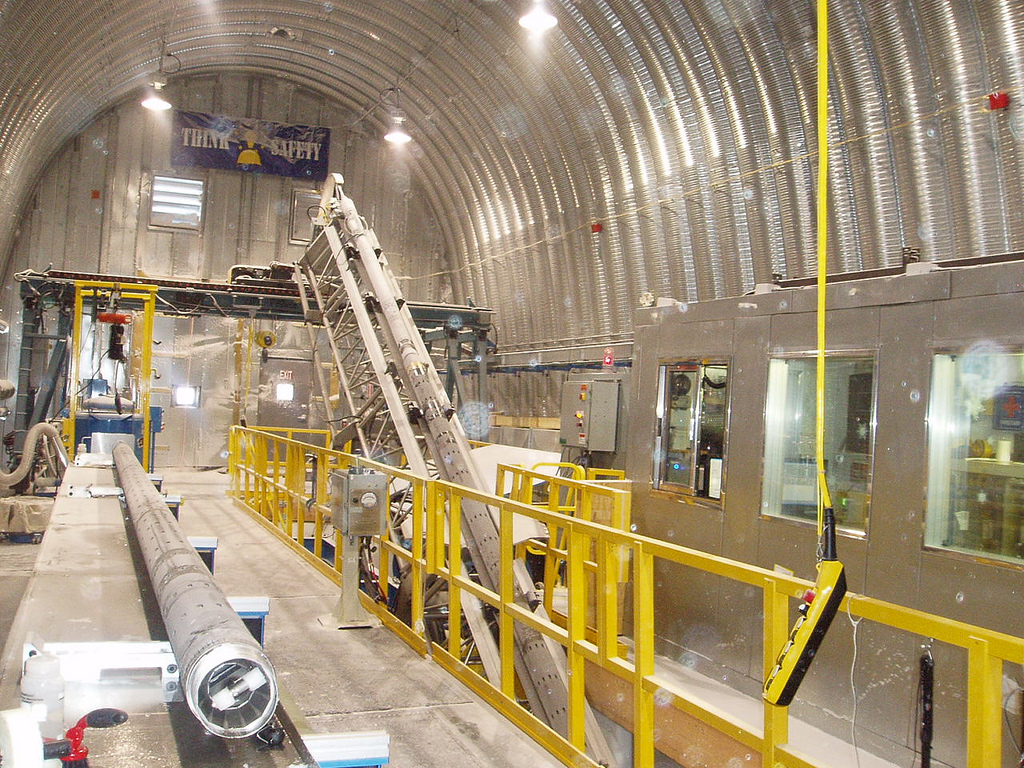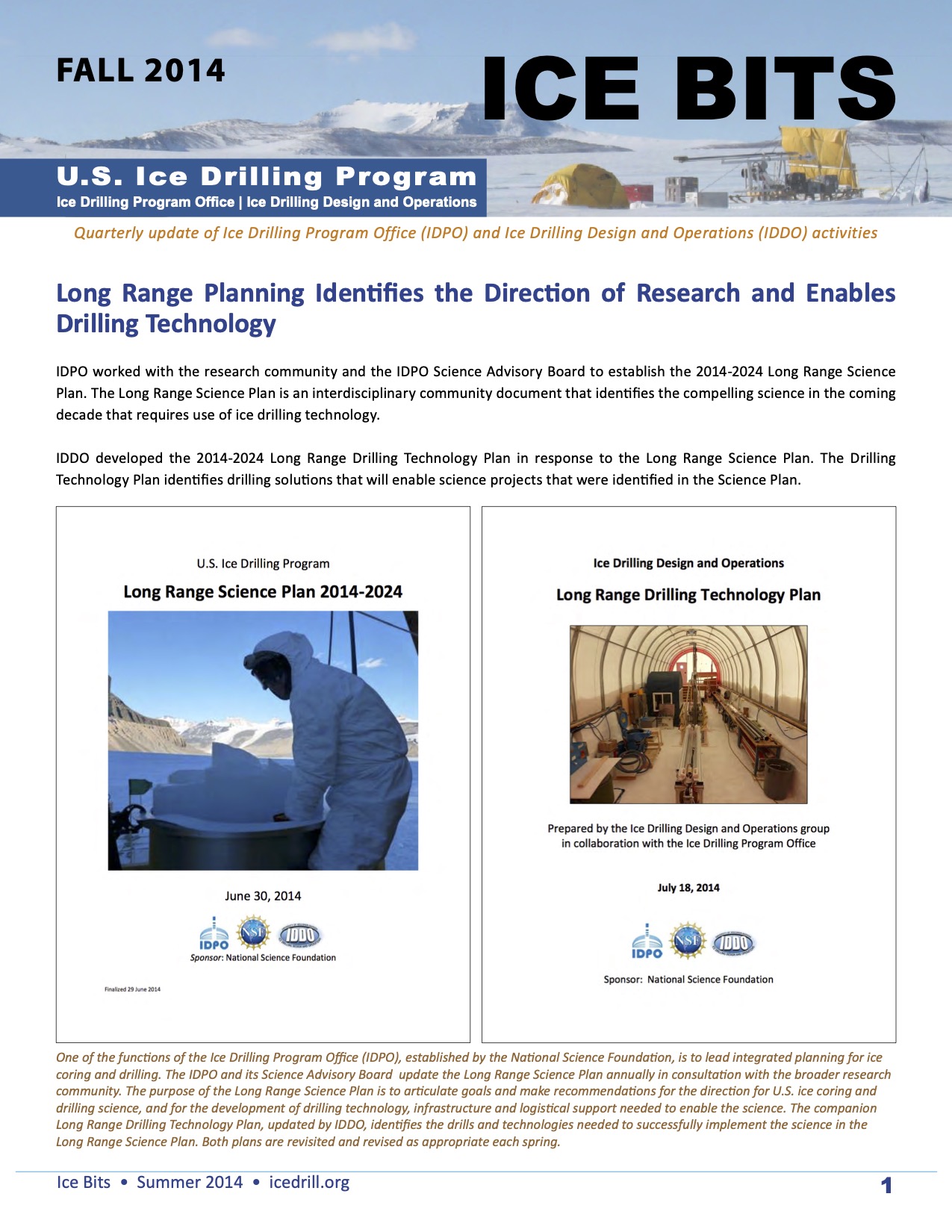Long Range Planning Identifies the Direction of Research and Enables Drilling Technology
- Long Range Plans
IDPO worked with the research community and the IDPO Science Advisory Board to establish the 2014-2024 Long Range Science Plan. The Long Range Science Plan is an interdisciplinary community document that identifies the compelling science in the coming decade that requires use of ice drilling technology.
IDDO developed the 2014-2024 Long Range Drilling Technology Plan in response to the Long Range Science Plan. The Drilling Technology Plan identifies drilling solutions that will enable science projects that were identified in the Science Plan.
IDPO Leads Reviews of Two IDDO Drills in Development
- Long Range Plans
- Agile Sub-Ice Geological Drill
On June 26, a technical review of the Scalable Hot Water Drill at IDDO was organized by Mary Albert. Participating reviewers included Martin Truffer, Keith Makinson, and Ted Scambos. A technical review of IDDO's Agile Sub-Ice Geological Drill was organized by Mary Albert and held on July 31. Technical reviewers were Drs. George Cooper, John Stone, Jaakko Putkonen, and Ed Brook. Both reviews were held via web teleconference using the IDPO web-conferencing ability; this enabled significant exchange of information while avoiding the need to travel.
Successful Field Test of IDDO's new Intermediate Depth Drill System in Greenland
- Intermediate Depth Drill (IDD)
Early in the third quarter, IDDO deployed a team of engineers and drillers to Summit Station, Greenland for a complete field test of IDDO's new Intermediate Depth Drill (IDD) system. Despite a delayed start to the season due to a mechanical issue with the LC-130 Hercules fleet, the IDDO team of six was able to successfully set up the entire drill system and put the equipment through its paces. Roughly 285 meters of ice core were drilled over the 14 days of testing, allowing IDDO engineers to test all of the new equipment. Twickler represented IDPO and participated in a site visit to the IDD test camp. All personnel returned to the U.S. on June 13 and the drill system followed in late June and early July. IDDO is now working to complete system repairs and modifications prior to shipping the drill to the South Pole station in late September for the South Pole Ice (SPICE) Core project. IDDO continued monthly teleconferences with ASC and the SPICE Core PIs in preparation for the IDD's deployment to the South Pole in November 2014. In addition, IDDO engineer/driller Tanner Kuhl attended the SPICE Core Planning Meeting in Centennial, Colorado on July 25, 2014.
Cosmogenic Carbon-14 Core Project Successfully Completed Following Early Season Challenges
- Blue Ice Drill (BID)
- Fieldwork
During the recent Arctic field season, IDDO again supported PI Vas Petrenko's Carbon-14 sampling efforts outside of Summit Station, Greenland using IDDO's Blue Ice Drill (BID). Despite early season challenges that saw one of the two IDDO drillers and three of Petrenko's science technicians returned home for medical reasons, the team rebounded during the following flight period. With assistance from additional science technicians and help from IDDO drillers already in Greenland for the IDD test, the team was able to successfully complete all drilling and sampling objectives. The large-diameter ice cores drilled by the BID were again melted onsite for in-field gas analysis. In addition to the use of the base BID system, IDDO also tested components of the new BID-Deep system, which will enable the drill to reach depths down to 200 meters. This testing was in preparation for a related project being conducted by Petrenko in the Dry Valleys region of Antarctica. BID-Deep testing resulted in the drilling of a 187 meter borehole. Core quality was found to be an issue after approximately 140 meters, however IDDO engineers were able to determine that the fabrication of less aggressive cutters should substantially improve core quality at these depths in the future. Over the course of the season, a total of 59 holes were drilled over 26 days of drilling. 1258 meters of core were recovered in a total of 1151 drill runs. The drill was returned to Madison in mid-July, where it was repaired and subsequently shipped to Antarctica in late August.
In addition to the large field projects supported by IDDO in Greenland, IDDO also provided hand auger and Sidewinder equipment to PI David Noone for the fourth and final season of his four-year field project. All equipment was returned to Madison for repair and cleaning following the field work. Another project in Northwest Greenland, PI Erich Osterberg completed shallow drilling outside of Thule Air Base, also using IDDO hand auger equipment. That equipment is in the process of being returned to Madison on flights of opportunity out of Thule.
Late in the third Quarter, in addition to all of the drill system repairs and modifications going on, IDDO also looked toward the upcoming Antarctic season, working with the Berg Field Center (BFC) in McMurdo as well as with PIs to plan for a variety of hand auger projects during the upcoming austral summer. IDDO also initiated the hiring process for the SPICE Core project, to be conducted at the South Pole using the Intermediate Depth Drill, and for the WAIS Divide Ice Core project, in which the DISC Drill will be fully disassembled and packed for return to the U.S.
IDPO Educational Outreach Develops New Interactive Map
- Education/ Outreach
A new interactive national map and supporting materials now point students to future careers in ice coring and drilling. A presentation with tips, links to career profiles and the map can be found at http://www.climate-expeditions.org/students/links.html#hotspots
If your university conducts ice core research and you'd like to have it added to the map, please contact Linda Morris at linda.m.morris@dartmouth.edu
New Technology for the Community (2014 Summer)
- Agile Sub-Ice Geological Drill
Scalable Hot Water Drill
After completing the science requirements for the Scalable Hot Water Drill (ScHWD) in late February, and after subsequent completion of the engineering requirements, several reviews of the conceptual design were scheduled and completed during the Third Quarter. On May 19, IDDO completed an internal review of the concept, inviting several former IceCube hot water drilling experts to participate. Mary Albert, via Adobe Connect, then hosted an external review on June 26, with participation from several community scientists. Drill designers Chris Gibson and Terry Benson presented the concept and will work to address reviewers' comments when they are received early in the next quarter. Detailed design of the system will likely be postponed until PY 2016, as there are currently no proposed field projects for use of the drill.
Agile Sub-Ice Geological Drill
Excellent progress was made on the Agile Sub-Ice Geological (ASIG) Drill during the Third Quarter, with the conceptual design readied for several reviews. On July 29, an internal review of the concept was held at IDDO, reviewing the project concept from a cost, scope and schedule perspective, as well as from an engineering perspective. On July 31, Mary Albert hosted a subsequent external review via Adobe Connect in which several community scientists and a former drilling engineering professor were able to ask questions after a presentation on the system. Overall, the conceptual design received excellent reviews and IDDO now looks forward to the next steps of purchasing the base drill rig and designing and fabricating all auxiliary equipment. Late in the quarter, IDDO was finalizing a Request For Proposals document, which will be sent out to mineral exploration rig vendors. IDDO plans to complete the fabrication and assembly of the drill system on time for its first deployment during the 2016-2017 Antarctic field season, and is also planning for a test of the system in North America sometime in late 2015 or early 2016.
Construction of the Rapid Access Ice Drill (RAID) Begins!
- Rapid Access Ice Drill (RAID)
The Division of Polar Programs at the National Science Foundation has recently awarded an $8.97M grant to the University of Minnesota Duluth to begin construction of the Rapid Access Ice Drill (RAID). This new drilling system will be able to penetrate the Antarctic ice sheets in order to take cores of the deepest ice, sample across the glacial bed, and continue coring into bedrock below. This new technology will provide a critical first look at the interface between the major ice caps and their subglacial geology.
RAID is a mobile drilling system capable of making several long boreholes in a single field season in Antarctica. The projected long-term research use of the RAID system is planned to begin in late 2017 by traversing to East Antarctica via the Amundsen-Scott station at the South Pole. The RAID system is designed to be self-sufficient once leaving a fixed U.S. research base, and it is compact enough to be operated by a 3-person drilling crew.
DOSECC Exploration Services (DES), LLC, a drilling and engineering company based in Salt Lake City, is the lead contractor to construct and test the drilling system. DES took the lead in development and engineering of the drill design, which began in June 2013.
John Goodge, professor of Earth and Environmental Sciences at the University of Minnesota-Duluth, is the lead principal investigator on the project. He studies geotectonic evolution of continental crust in East Antarctica and the Transantarctic Mountains. Jeff Severinghaus of Scripps Institution of Oceanography, co-principal investigator, conducts research on Antarctic paleoclimate by study of ice cores.
Construction of the drilling system began in June, 2014. Initial field tests of the system in North America are scheduled for early 2015, to be followed by a set of field validation trials in Antarctica in the 2016-17 austral summer.
The RAID platform is designed to address a wide range of interdisciplinary research goals of the international scientific community. These include a search for polar paleoclimate records in ice greater than 1 million years old, observation and sampling of the base of the Antarctic ice cap, and recovery of rock cores from ice-covered geologic provinces of Antarctica, a virtually unknown continent larger than the continental U.S. By keeping the boreholes open with a stabilizing fluid after drilling is complete, researchers will also be able to lower instruments and logging devices into the boreholes in order to measure thermal gradient, heat flow, ice accumulation history, and ice deformation processes. RAID will also sample for extremophile micro-organisms that may be present at the base of the ice sheets.
This new drilling system is based on modification of an industry-standard diamond rock-coring system as used in mineral exploration. Threaded metal drill pipe sections will be assembled at the surface as the drill cuts its way downward through ice using customized metal bits. A special circulating fluid will be used to lubricate the drill pipe, maintain proper temperature at the cutting surface, and return ice cuttings to the surface, where they will be separated from the recirculating fluid. Near the bottom of the ice sheet, diamond tools will be lowered through the drill string to enable coring of ice, material in the glacial bed, and the solid bedrock below. These cores will be returned to the surface in sections by use of a wireline retrieval system. Once drilling is complete, the boreholes will be maintained with a stabilizing fluid, capped, and made available for future down-hole measurements.
RAID is designed to penetrate up to 3,300 meters of ice (nearly 11,000 ft) and take sample cores in less than 200 hours. This rapid performance will allow a drilling crew to operate from start to finish in about 10 days before moving on to the next drilling site.
RAID is unique because it can provide fast borehole access through thick ice; short ice cores at the base of the ice sheet for paleoclimate study; cores of the glacial bed to determine flow conditions; cores of subglacial bedrock for age dating and crustal history; and create boreholes that can be used as an observatory in the ice sheets. Together, the rapid drilling capability and mobility of the drilling system, along with ice-penetrating imaging methods, will allow scientists to build a 3D picture of the interior Antarctic ice sheets in a way that has never been done before.
RAID contact information:
John Goodge
Professor of Earth & Environmental Sciences
University of Minnesota-Duluth
218-726-7491
jgoodge@d.umn.edu
Jeff Severinghaus
Professor, Scripps Institution of Oceanography
UC-San Diego
858-822-2483
jseveringhaus@ucsd.edu
Don Lebar Retires After Nearly 13 Years as Head of UW-Madison's Ice Drilling Group
By Kristina Slawny
Don Lebar, Program Director of Ice Drilling Design and Operations (IDDO), recently announced his retirement from the University of Wisconsin-Madison, effective July 3, 2014. I had the opportunity to sit down with Don to talk about his noteworthy tenure at UW, as he reflects on successes and challenges, and looks ahead to the new chapter of retirement.
Born in Rock Springs, Wyoming, Don attended the University of Wyoming, completing a bachelor's degree in mechanical engineering in 1971. Don then worked for Questar Corporation, a natural gas energy company based in Salt Lake City, Utah, and enjoyed the challenges of integrating engineering practices and quality concepts. It was also at Questar where he met his wife, Nancy.
With an interest in engineering management, Don began pursuing an MBA at Westminster College in Salt Lake City and, subsequently, at the age of 50, left Questar to pursue his graduate degree full time. Despite being accepted into several MBA programs, the University of Wisconsin-Madison was a natural choice, particularly since his wife's family was located in and around Wisconsin. Apart from school and work, Don has been a member of the American Society of Mechanical Engineers (ASME) for the past 40 years, as well as a member of the American Society for Quality (ASQ) for the past 20 years.
In 1999, Don began the Master of Business program at UW- Madison, graduating in 2001 with a master of business degree in Manufacturing and Technology Management (MTM). After graduation, Don intended to do consulting work, but received a phone call in July 2001 from Bob Paulos, a project manager at the Space Science and Engineering Center (SSEC) on the UW campus, which would take his career in a new and exciting direction.
A fellow student in the MTM program, who was working at SSEC, had recommended Don for a position in his building. Don interviewed with both Bob and Charlie Bentley, the latter of whom was the principal investigator (PI) of Ice Coring and Drilling Services (ICDS), an engineering group within SSEC working under a grant from the National Science Foundation (NSF) to maintain the foundation's fleet of polar ice coring equipment as well as support science projects worldwide.
Don commented on how the job was the perfect fit, as it allowed him to blend three of his passions – engineering, management and science – into one position. In August 2001, Don was hired as the program manager of ICDS.
Years later, in 2008, ICDS became the Ice Drilling Design and Operations Group (IDDO), and began to operate under a cooperative agreement with the NSF and collaborate closely with a new organization, the Ice Drilling Program Office (IDPO) based at Dartmouth College and the University of New Hampshire. IDDO's goal was to carry on with the drill development, maintenance and upgrade tasks, and the field deployment of equipment and personnel that it had been doing for years. IDPO, in turn, would work with the science community to help determine equipment needs for the next decade and beyond.
In talking with Don about the things he has enjoyed most about his time at SSEC/ICDS/IDDO, Don said it is really the people within the organization that make it most satisfying – that, and the appeal of supporting critical science through a great array of polar projects over the years, have been very fulfilling, he said.
Having supported nearly 60 field projects since 2001, I asked Don if he had any favorite projects. Don discussed one particular project, the West Antarctic Ice Sheet (WAIS) Divide Deep Ice Core project, saying it was one of the most rewarding.
To date, the WAIS Divide Deep Ice Core project is the largest and longest project in the history of ICDS/IDDO. To complete the project, ICDS/IDDO designed and built the Deep Ice Sheet Coring (DISC) Drill, which operated at WAIS Divide in West Antarctica from 2007-2013. The WAIS Divide Ice Core is the deepest U.S. ice core collected to date.
Don recalled several things that drove the project's success, including close collaboration with WAIS Divide Chief Scientist Kendrick Taylor. This idea of collaboration between science and engineering set the tone for the project, with input from key players throughout its execution. ICDS/IDDO was also able to hone its driller-screening process during the multiyear project, gathering a premier group of hardworking and talented drillers from across the U.S. and the world. Don has always been a true believer in the effects of crew morale on performance in the field, noting that good relationships and morale lead to safe and successful working environments.
Don went on to discuss what a privilege it has been to work under Charlie Bentley during his time at UW, saying, "I couldn't have asked for a better boss." While Don and Charlie had somewhat different perspectives, with Charlie championing the science of the fieldwork and Don promoting the engineering and customer service aspects of the organization's work, he noted that he and Charlie were a good complement to one another and were always headed in the same direction.
Several other strides ICDS/IDDO has made over the years have contributed to the organization's success, Don noted. Having assembled a great staff of dedicated and hardworking engineers, project managers and support staff, the work of ICDS/IDDO unearthed some questions and discoveries over the years, particularly with regard to drill design and cutter performance. This, in turn, led ICDS/IDDO to enhance and build up its test lab capabilities in recent years. Since polar projects are supported in such remote locations, often offering a single chance for success, the emphasis on testing, documenting and learning will continue to benefit ICDS/IDDO for years to come.
In addition to improvements in engineering practices, Don also led the way toward establishing beneficial business tools and systems. Don spearheaded development of an integrated project management tool for IDDO, which suits the size of the organization, is useful for reporting purposes and allows for tracking program progress through Earned Value Management (EVM) metrics. Additionally, Don reflected on ICDS/IDDO's efforts toward continuous improvement, highlighting how the PI feedback surveys distributed to investigators bring the idea of customer service to the university.
Since no job comes without challenges, I asked Don what the most difficult part about his tenure as Director has been. He noted that tight timelines in drill design and repair, particularly between the Arctic and Antarctic field seasons, often pull him and the staff in many directions. Over time, increased reporting requirements and adhering to processes has also stressed the small staff of ICDS/IDDO.
As for changes Don has witnessed in his time at UW, he commented that the vast improvement in ICDS's/IDDO's working relationships with scientists over the years has been very rewarding. ICDS/IDDO has always worked to collect feedback from the science community on its support of field projects, and an expended iterative process between ICDS/IDDO and the community has been of benefit to all involved. Don also expressed that, while it took a few years after the start of the ICDS contract to gain the trust of the science community, the resulting relationships have greatly improved and are incredibly productive and rewarding.
I asked Don what advice he could give to his successor and to his staff, as he departs and leaves them to carry on his work. He said that it is important to be up-front and honest with people, both staff and customers, as this engenders trust and keeps people on the same page, working toward the same goal. He expressed that it is important to view and treat people like people, and not as resources. Focusing on your staff and your customers will take you far. Don has always encouraged his staff to "invent your job", within reason, as this allows people to pursue what they love, which is valuable to that individual and the organization as a whole.
As for what's next for Don, he said that in retirement he will be spending more time with his grandkids and hopes to get back outside to go camping and hiking. He also hopes to reconnect with his hobbies of photography, having recently purchased a new SLR camera, reading and music, commenting that he has a substantial "book backlog" and hopes to organize, listen to and learn more about the music in his collection.
ICDS and IDDO have grown tremendously under Don's guidance over his nearly 13 years with the University of Wisconsin. Don has been a great leader, listener and friend to his staff and colleagues over the years and he will certainly be missed. We wish Don all the best in his retirement!

